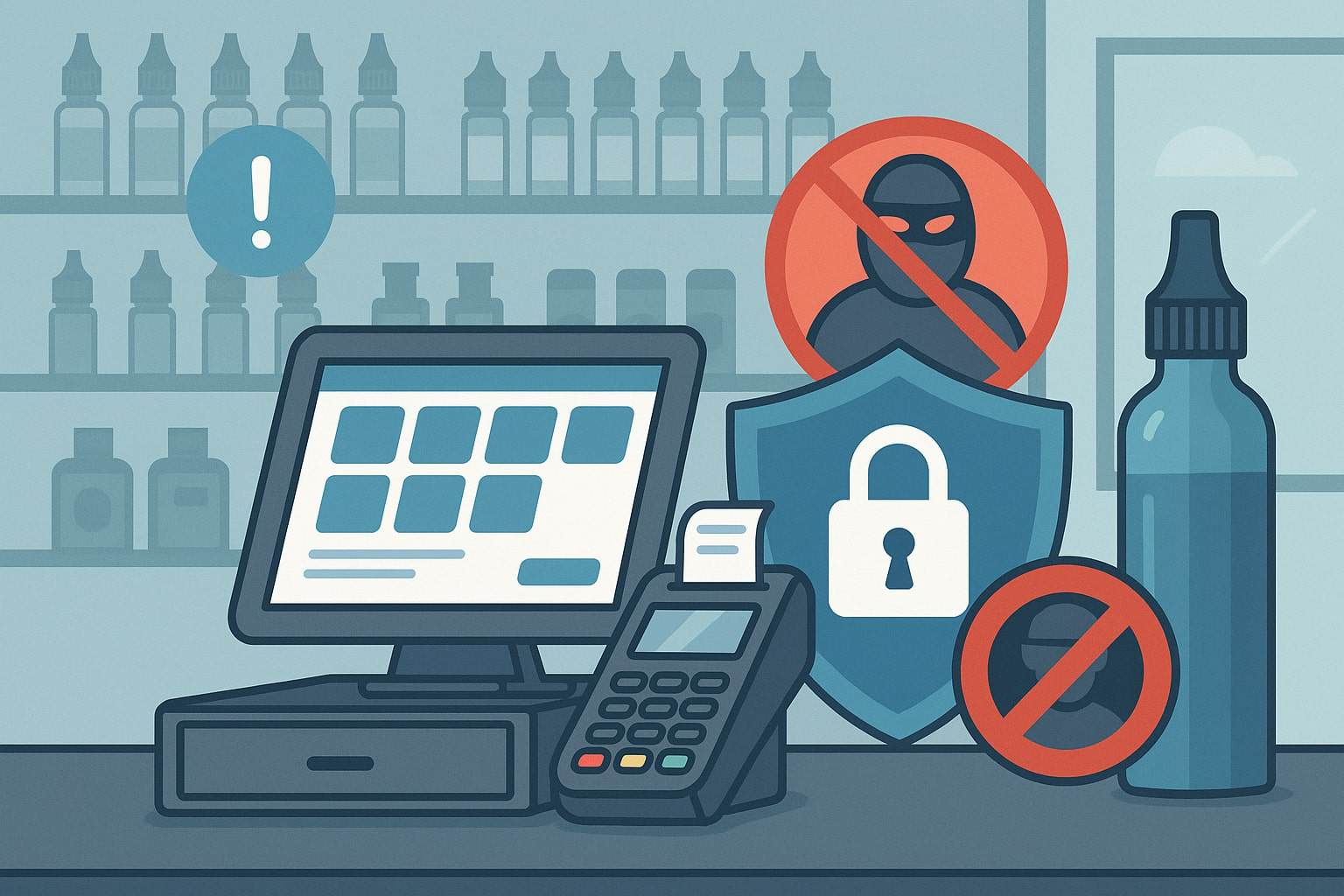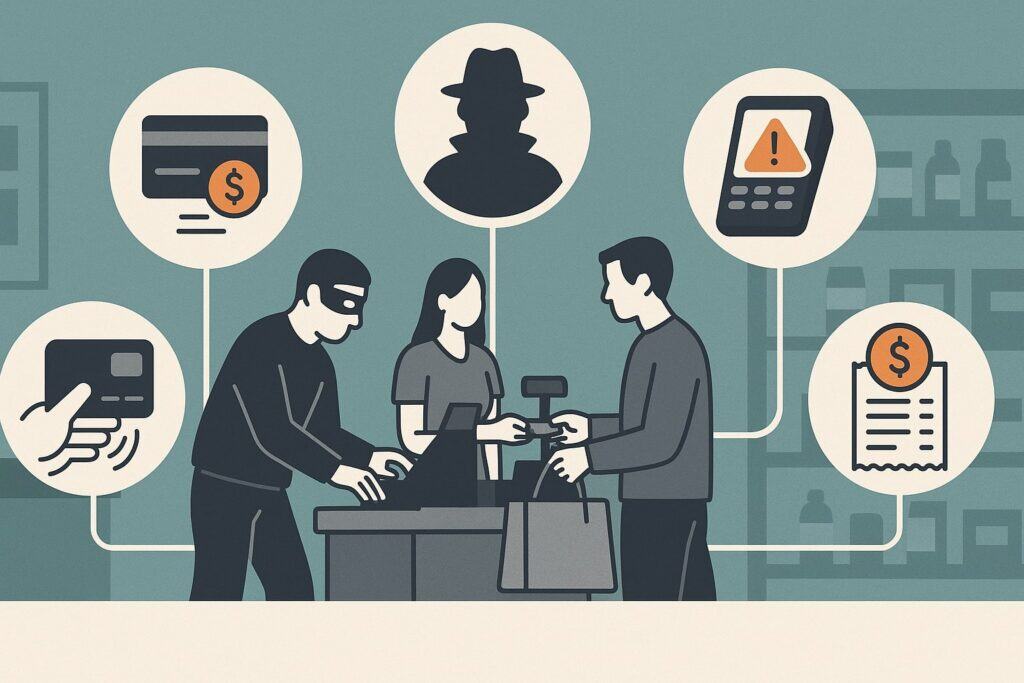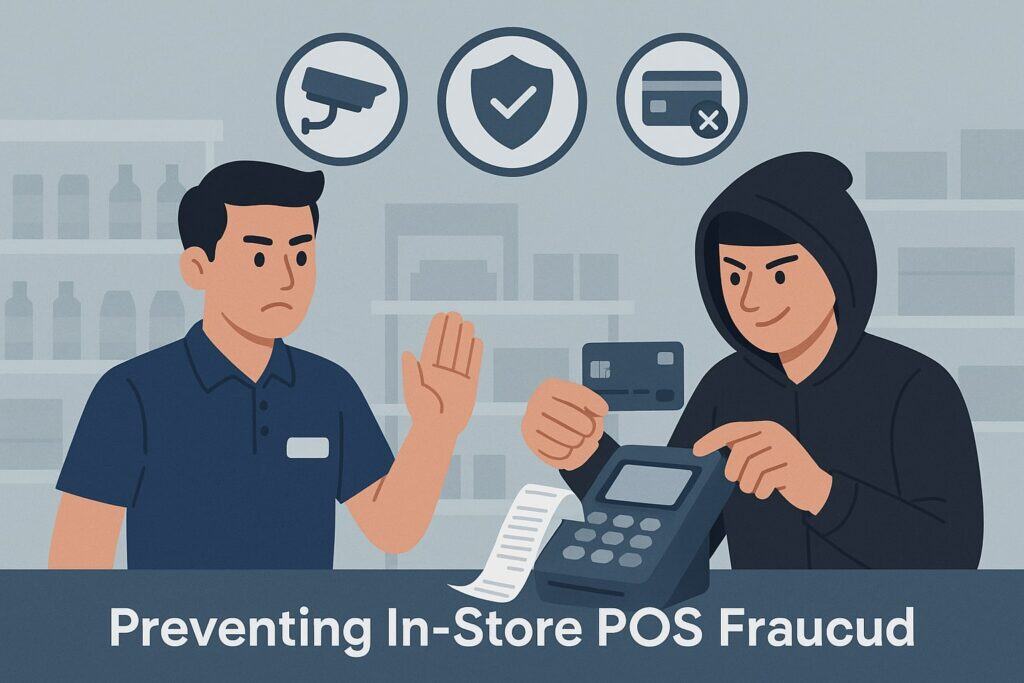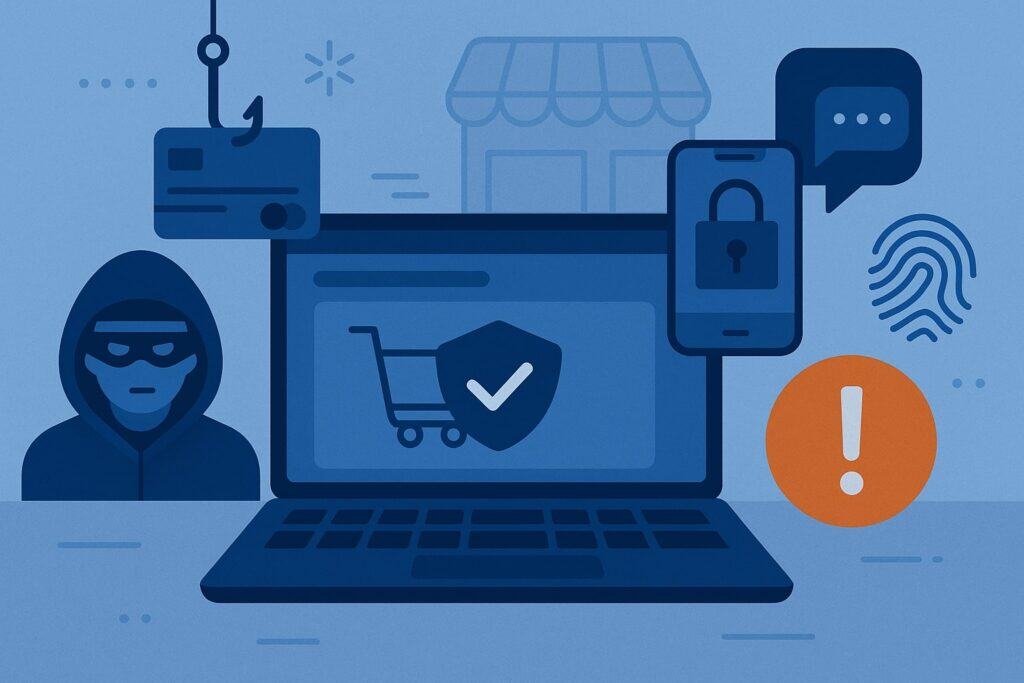
By vapeshoppointofsale September 13, 2025
In the fast-growing U.S. vaping market (projected to hit $9.4 billion by 2025), vape retailers face unique fraud challenges. High-ticket vaping hardware, frequent age-check rules, and evolving regulations make fraud prevention critical.
From in-store theft to online payment scams, every transaction must be secured. For example, new federal rules now require checking the ID of anyone under 30 for vape sales, making robust POS age verification a must.
A vape shop cashier uses a POS terminal. Modern POS security tools (like ID scanners and digital receipts) can flag fraud at the register. High-risk stores are prime targets. As Lifelong Merchant Services notes, large purchase sizes and regulated products make vape shops attractive fraud targets.
Common schemes include counterfeit IDs, friendly chargebacks, unauthorized refunds, and even employee skimming. Unchecked, these losses quickly erode profits and can jeopardize a merchant account.
In-Store Fraud Risks and Examples

Vape shops encounter several in-store fraud tactics:
- Credit Card Chargebacks: A customer disputes a legitimate vape purchase, often claiming they don’t recognize the charge. These “friendly fraud” disputes can balloon fees and risk high‑risk account closure.
- Underage Sales (Fake IDs): Minors may use fake or borrowed IDs to buy tobacco or vape products. Even one sale under 21 can trigger a dispute or legal penalty.
- Refund/Return Abuse: Scammers return used or empty vape containers for a refund. Without strict controls, they exploit lenient return policies.
- Internal Theft (Shrinkage): Employees might collude to steal inventory or manipulate sales. Retailers typically lose 1–2% of sales to such shrinkage. Shrinkage often stems from theft, errors, or fraud.
Table: Common fraud types in vape shops and countermeasures.
| Fraud Type | Example | Prevention Tools |
|---|---|---|
| Chargeback Fraud | Disputed vape purchase | Detailed receipts, customer signatures, and logged POS notes; prompt address/CVV checks |
| Fake ID / Underage Sale | Minor using fake ID | POS age-prompt and ID scanner |
| Refund/Return Abuse | Returning used e-liquid | Manager approval for returns; track all refunds in POS |
| Employee Theft | Cash drawer skimmed | Surveillance/CCTV and regular audits; strict inventory controls |
| Online Card Fraud | Stolen card on checkout | AVS+CVV verification and 3D-Secure authentication |
| Friendly Fraud | Legit purchase disputed | Email receipts, custom billing descriptors; dispute alerts |
| POS/Data Breach | System hack (data theft) | End-to-end encryption, tokenization, PCI-DSS compliance |
Preventing In-Store POS Fraud

A vape shop’s POS system can be its first defense. Key steps include:
- Automatic Age Checks: Configure the POS so it always prompts for ID when ringing up age-restricted items. Many systems support ID scanners or barcode readers to read driver’s licenses, ensuring a valid date of birth.
- Digital Receipts and Descriptors: Issue itemized receipts that list each product by name or SKU. Clear store/contact info and detailed line-items reduce confusion (a common chargeback trigger). Emailing receipts can also provide customers with records to resolve disputes.
- Signature Capture & Logs: For high-value sales, use signature capture or PIN entry. This creates proof of the transaction. Likewise, the POS should log every action (sales, refunds, discounts) with user IDs. Such an audit trail is invaluable in investigations.
- Locked-Down Permissions: Limit who can give discounts or process refunds. Ideally, only managers should have keys to refund or void permissions in the POS.
By locking down these functions, you prevent staff from issuing unauthorized “friend and family” discounts or processing phony returns. - Inventory Monitoring: Use POS-integrated inventory software to track stock in real time. Automated alerts for missing or low stock can flag potential shrinkage. Periodic cycle counts with barcode/RFID scanning quickly reveal discrepancies.
- Surveillance and Analytics: High-resolution video tied to POS transactions can deter theft. Modern systems even offer AI-powered analytics to spot odd customer or employee behavior.
For example, advanced POS platforms can generate alerts on unusual return patterns or spike in discounts.
By combining technology with policy, stores can cut risks significantly. A recent case study notes that after a retailer deployed a POS solution with age scanning and thorough receipt tracking, chargeback rates plummeted.
Online Fraud & E-Commerce Security

For vape shops selling online, card-not-present fraud is a major threat. Best practices include:
- Secure Payment Gateway Filters: Configure your gateway to flag or block risky transactions. For example, restrict sales to your normal region, reject non-U.S. cards if you only ship domestically, and flag unusually large orders.
- AVS & CVV Verification: Always require the card’s billing ZIP code (AVS) and CVV code during checkout. AVS compares the billing address to the one on file with the card issuer – mismatches are a red flag. Requiring the CVV code (the 3- or 4-digit security number) ensures the buyer has the physical card.
- 3D Secure Authentication: Enable 3D Secure (e.g. Verified by Visa, Mastercard SecureCode). This adds a step (usually a one-time PIN or mobile biometrics) confirming the cardholder’s identity. According to Stripe, 3DS can shift liability away from the merchant if fraud occurs.
- Chargeback Alerts and Monitoring: Sign up for instant chargeback alert services (e.g. Ethoca or Visa’s Resolve). These notify you immediately when a customer disputes a charge, often before the funds are debited.
You can then proactively cancel shipment or contact the customer to resolve the issue, saving you chargeback fees. - Strong Authentication: Consider adding multi-factor authentication for customer accounts, and tools like device fingerprinting or “velocity” checks (limits on number of cards or transactions per day).
Leading fraud fighters recommend AI/ML systems that learn normal customer behavior and flag anomalies. - PCI-DSS and Encryption: Ensure your website and gateway are PCI compliant. Data must be encrypted in transit (SSL/TLS) and at rest. Use tokenization so card details aren’t stored on your server.
Lightspeed emphasizes choosing a PCI DSS–certified payment processor with built-in fraud screening (AVS, CVV, etc.).
By layering these defenses, an online vape retailer makes it very hard for fraudsters to succeed. Even so, maintain clear refund policies and active customer support so that genuine buyers have recourse — this also discourages “friendly fraud” chargebacks.
Regulatory Compliance & Age Verification

Vape shops must juggle fraud prevention with strict laws on tobacco sales. In 2024, the FDA raised its carding age: now clerks must verify with photo ID anyone under 30 buying tobacco products (including vapes). Violations risk fines or losing licenses.
- Integrated ID Scanning: To comply easily, invest in a POS that forces age checks. Many vape-focused POS systems include Age Verification Technology (AVT).
This means the cashier gets an on-screen prompt for every vape sale, and an ID scanner can automatically read and validate driver’s licenses. Digital ID readers will flag expired or fake IDs. - Electronic Logs: Good POS software will record each scan or age prompt. This builds proof for inspections: you can show the percentage of sales where ID was scanned. Some systems even integrate with reward programs, ensuring even loyalty sales meet age rules.
- Online Age Gates: For e-commerce, use an age-verification service at checkout. This might require customers to upload a photo of their ID or answer challenge questions.
Companies like FTx (FasTrax) offer apps that meet tobacco industry standards, quickly verifying age for online orders. - Regular Staff Training: All employees should know they must card under-30 patrons every time, even if they seem of age. Role-playing and quizzes can help reinforce this.
Meeting these rules not only avoids legal trouble, it also reduces fraud. A POS that is fully AVT-compliant can even qualify for incentives from tobacco manufacturers (which reward strict ID checks). In short, using technology to enforce age checks protects your bottom line on multiple fronts.
Essential POS Security Features
When choosing or upgrading your POS, look for these features tailored to vape stores:
- End-to-End Encryption: The system should encrypt card data at capture so that your network never sees raw credit card numbers. Tokenization is ideal – after a sale, the card info is replaced by a secure token, eliminating stored data risk.
- Integrated Fraud Detection: Some modern POS solutions include built-in fraud rules. For example, they may flag if a card is used repeatedly with different IDs, or if multiple high-value returns happen on one account. Robust systems even let you attach receipts and IDs directly to transactions for easy dispute defense.
- Comprehensive Reporting: Look for rich analytics and dashboards. A good vape-shop POS will report not just sales, but also return/discount patterns, inventory shrinkage, and customer behavior. This helps catch anomalies (e.g. a spike in missing inventory or discounts) before it drains profit.
- Flexible Payments: Support EMV chip and contactless (NFC) payments, Apple/Google Pay, and high-risk credit card processing. Faster, secure payment options (e.g. tap-and-go) reduce the chance of skimmers or outdated magnetic stripe fraud.
- Cloud-Based Management: A cloud POS ensures data is backed up and accessible remotely. Owners can instantly see sales and inventory across all shifts or locations. In a breach or error, you can isolate or update systems quickly. Cloud systems also typically auto-update security patches.
- Customer-Facing Display: Use a display that shows line-items and prices as the cashier rings them up. This transparency helps customers verify their purchase before completing payment, reducing disputes. Some displays also show age-verification reminders or terms of sale to the customer directly.
CigarsPOS (a tobacco shop POS provider) emphasizes that a tailored POS should fully support age verification, automated tax on vapes, and strong encryption.
Likewise, Lightspeed recommends only using payment processors that handle all PCI-DSS requirements and offer built-in AVS/CVV checking. Together, these features create layers of protection.
Employee Training and Store Policies
Technology alone isn’t enough – trained staff and clear policies make POS tools effective. Best practices include:
- Formal ID Policy: Post clear signage (“We Card Anyone 30 or Younger”) and require every cashier to ask for ID for all customers under 30. Have employees practice how to check IDs discreetly. Consider a cache flow or counting trick to verify age (e.g. adding 21 to the birth year vs. 30 minus birth year).
- Consistent Procedures: Institute strict cash-handling and return procedures. For example, no refunds without a manager; no comping or freebies without supervisor approval.
When every refund or discount is hand-on-hip audited, abuse becomes harder. Strengthen accountability by making each staff member use a unique login PIN. Lightspeed suggests treating your staff as the first line of defense in shrinkage and fraud. - Fraud Awareness Training: Educate employees on common scams: fake coupons, ID tricks, diversion schemes, etc. Role-play scenarios like spotting a plausible-looking fake driver’s license.
Emphasize reporting suspicions. According to Lightspeed, interactive security training and a culture of accountability are key to combating shrinkage. - Regular Audits: Periodically review POS logs. Check that inventory counts match sales. The retailer Goodwill found that switching to a modern POS with audit reports helped uncover employee theft immediately. Random spot checks (e.g. end-of-day drawer counts, mystery-shop underage checks) keep staff vigilant.
By pairing tech with clear rules, vape shops create a self-enforcing system: employees know that slips will be caught by the POS, and customers realize the store’s transactions are well-monitored.
POS Systems and Tools for Fraud Prevention
Several POS vendors offer smoke- or vape-shop solutions with built-in security:
- Age Verification Modules: Systems like FasTrax (FTx POS) or Cova feature integrated ID scanning hardware and Age-Gate prompts that can’t be bypassed. These log every card swipe of ID and help you meet FDA/Altria requirements automatically.
- Cloud & Mobile Payments: Cloud-based vape POS solutions provide secure mobile checkout options. For instance, Lightning NFC or QR-code payments reduce contact and encrypt payment data in hardware. Combining mobile pay with real-time POS syncing can cut down fraud tied to manual entry errors.
- Real-Time Alerts & Dashboards: Look for POS software that offers instant notifications. Lifelong’s POS, for instance, will alert management the moment a chargeback hits, allowing immediate response. Many systems also let you attach digital evidence (scanned receipt, camera still) directly to a transaction.
- Anti-Theft Integration: Some POS tools connect with RFID/EAS gates. For example, tagging e-liquid bottles with RFID means the POS knows the item was sold when the tag deactivates. This cuts shoplifting – Lightspeed suggests using RFID and POS analytics together to pinpoint shrinkage.
- Analytics & Fraud-Fighting Apps: Specialized software can sit on top of your POS. Services like FastoSafe claim AI-driven fraud scoring for vape retailers.
Whether built-in or third-party, these tools analyze sales data and customer behavior 24/7, flagging anything unusual. As one expert blog notes, automating fraud checks (even via machine learning) is increasingly common in high-risk retail.
In short, invest in systems made for highly-regulated retail. CigarsPOS, for example, advises using a POS with automated age-checks, compliant tax codes, and tokenized payments for vape shops. And Lightspeed stresses that seamless POS/processor integration eliminates many manual errors that invite fraud.
FAQs
Q: How can I reduce chargebacks in my vape shop?
A: Use clear, descriptive receipts and require customer acknowledgment of sales. For example, itemized digital receipts (via email) with your store name reduce confusion. Always log any refunds or order changes.
A POS that sends instant chargeback alerts lets you respond immediately with evidence (like a signed receipt) to win disputes.
Q: What is the best way to prevent underage vape sales?
A: Follow FDA rules and use tech to enforce them. Card anyone 30 or younger, every time, and never rely on memory. Implement POS age prompts and ID scanning at checkout.
Train staff to ask for IDs consistently. Some shops even use electronic verifiers that swipe driver’s licenses (which read the encoded DOB) to automate checks.
Q: Which POS features help stop fraud in vape shops?
A: Look for a POS with built-in age verification, end-to-end encryption of card data, and inventory analytics. Good systems prompt the cashier to scan IDs and capture digital signatures.
They encrypt and tokenize payment info. They also provide robust reporting – e.g. alerts on unusual return rates or stock variances. Choosing a vape-specific POS often gives you these tools out of the box.
Q: How do I secure my online vape sales?
A: Use a secure payment gateway and enforce AVS/CVV checks. Enabling 3D Secure (Verified by Visa/Mastercard) adds an OTP step for cardholders.
Configure your gateway to block risky transactions (foreign IPs, mismatched country of purchase). Also maintain clear shipping/return policies and consider requiring order confirmations for large purchases.
Q: Are there regulations that affect my POS use for vape products?
A: Yes. Besides age restrictions, you must follow privacy and PCI requirements. Ensure your payment processor is PCI DSS compliant and never store card data unencrypted.
Display signs like “We Card 30 and Under.” Update your POS for any tax changes on vaping supplies. Staying compliant avoids fines and also deters fraud by making procedures formalized.
Conclusion
Fraud at the point of sale can sink a vape shop, but it is manageable with diligence and the right tools. In both brick-and-mortar and online channels, the strategy is the same: layered defense.
Use your POS system to enforce rules (age checks, logged receipts), leverage technology (encryption, AVS, cameras), and train your team in best practices. Stay current with regulations (carding anyone under 30) and choose payment partners who specialize in high-risk retail.
A well-configured vape-shop POS – one that locks down refunds, automates ID scans, and detects anomalies – becomes your strongest ally in stopping theft and chargebacks. By combining this technology with strong staff protocols, vape retailers can protect their bottom line and focus on serving customers safely.